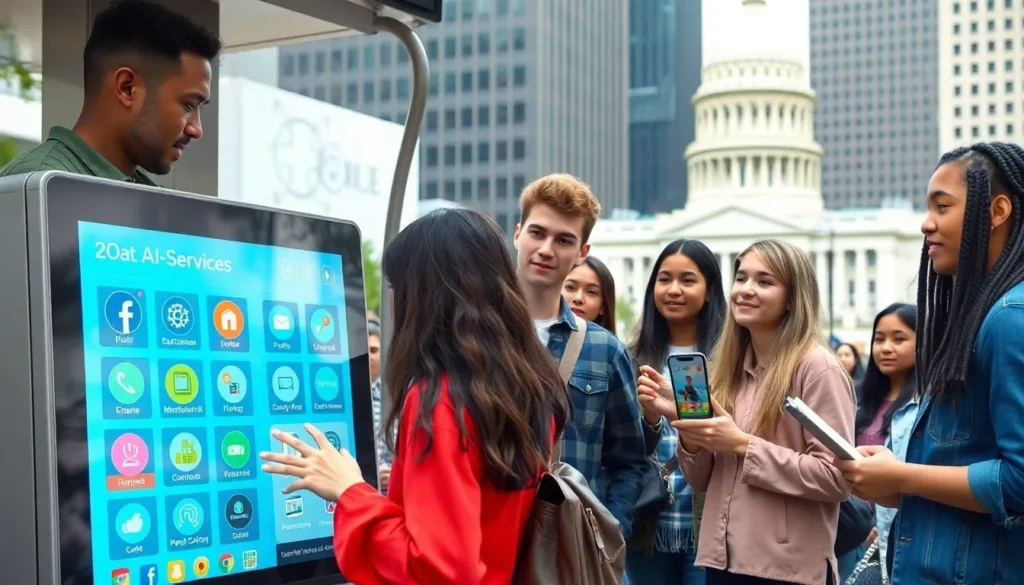Table of Contents
ToggleIn a rapidly evolving digital landscape, AI-driven government services are transforming the way citizens interact with their governments. By harnessing the power of artificial intelligence, agencies can streamline operations, enhance decision-making, and deliver personalized services like never before. This shift not only improves efficiency but also fosters greater transparency and accountability.
As governments worldwide embrace these innovative technologies, they’re setting the stage for a new era of public service. From chatbots that provide instant information to predictive analytics that anticipate community needs, AI is reshaping the public sector. Understanding the impact of these advancements is crucial for citizens and policymakers alike, as they navigate the complexities of a digital future.
Overview of AI-Driven Government Services
AI-driven government services transform how citizens interact with their governments. These innovations enhance operational efficiency, decision-making, and personalized service delivery.
Definition and Importance
AI-driven government services involve the use of artificial intelligence technologies to improve public services and streamline operations. Machine learning, natural language processing, and data analytics serve as core components. These technologies facilitate better resource allocation and faster service delivery, increasing citizen engagement and trust in government processes. The importance of AI in this context lies in its ability to make services more accessible, efficient, and responsive to the needs of the public.
Historical Context
The integration of AI in government services has evolved significantly over the past decade. Initial implementations involved basic automation and data processing tasks. By the mid-2010s, many governments began adopting chatbots for citizen inquiries and service bookings. The growth of big data analytics showcased its potential for predictive modeling and informed decision-making. As technology advanced, governments worldwide recognized AI’s capacity to enhance transparency and accountability, setting the stage for widespread adoption of AI-driven initiatives in public service.
Benefits of AI-Driven Government Services

AI-driven government services offer significant benefits, particularly in efficiency and citizen engagement. These improvements lead to streamlined operations and a closer connection between governments and their constituents.
Improved Efficiency
AI technologies automate routine tasks, reducing time and resources spent on administrative duties. Machine learning algorithms process vast amounts of data quickly, enabling faster decision-making. Chatbots provide immediate responses to citizen inquiries, enhancing service responsiveness. Predictive analytics identify trends and patterns, allowing governments to allocate resources more effectively. As a result, organizations experience reduced operational costs and improved service delivery rates.
Enhanced Citizen Engagement
AI tools foster a more interactive relationship between citizens and government entities. Personalized services cater to the unique needs of individuals and communities, increasing satisfaction rates. Data analytics enhance transparency by providing insights into government actions and spending. AI-driven platforms enable real-time feedback, allowing citizens to express concerns and suggestions efficiently. Consequently, trust in government institutions strengthens, fostering a collaborative environment where public services better meet the needs of all citizens.
Challenges and Considerations
AI-driven government services present specific challenges that require careful consideration. These challenges revolve around privacy, security, equity, and accessibility.
Privacy and Security Concerns
Privacy and security concerns dominate discussions about AI-driven government services. Citizens expect their data to remain confidential and protected from unauthorized access. Governments must implement robust cybersecurity measures and adhere to strict data governance policies. Ensuring compliance with regulations, such as the General Data Protection Regulation (GDPR) in Europe, is paramount in maintaining public trust. Furthermore, transparent data usage policies foster citizen confidence while mitigating risks associated with potential data breaches or misuse.
Equity and Accessibility Issues
Equity and accessibility issues arise as governments implement AI technologies. Not all citizens possess equal access to digital tools, creating disparities in service delivery. Marginalized communities may face barriers, including limited internet connectivity and technological literacy. Governments must prioritize inclusive design to ensure that AI services cater to diverse populations. Proactive outreach, education, and investment in technology infrastructure can bridge these gaps. Focusing on universal accessibility fosters equitable opportunities for all citizens to engage with government services effectively.
Case Studies of Successful Implementation
AI-driven government services demonstrate tangible benefits across various jurisdictions, showcasing effective applications of technology to improve citizen services.
Examples from Different Countries
- Estonia: Estonia has implemented e-Residency, allowing global citizens to access various government services online. This initiative streamlines business registration and taxation, fostering economic growth. AI algorithms analyze user data to enhance the platform and address citizen needs efficiently.
- Singapore: Singapore’s Smart Nation program utilizes AI to optimize public transportation. Through data analytics, it predicts traffic patterns, improving transit scheduling and reducing congestion. AI-based chatbots offer real-time information and support to commuters, enhancing service responsiveness.
- United States: Several U.S. states employ AI for fraud detection in public assistance programs. Machine learning models analyze transactional data to identify suspicious activities, ensuring resources are allocated appropriately. This increases operational efficiency while minimizing errors in assistance distribution.
- India: The Digital India initiative leverages AI to improve agricultural practices. Through predictive analytics, farmers receive tailored weather forecasts and market insights, optimizing crop management and enhancing productivity. This initiative fosters economic resilience in rural communities.
Lessons Learned
- Integration of Technology: Successful implementation requires seamless integration of AI with existing systems. Governments must invest in infrastructure to support these technologies, ensuring compatibility and functionality.
- Citizen Engagement: Active citizen engagement leads to more successful AI initiatives. Governments that involve citizens in the design process capture diverse needs and foster greater trust in services.
- Data Governance: Consistent data governance frameworks ensure data privacy and security. Maintaining public trust hinges on transparent data management practices and adherence to regulatory standards.
- Continuous Improvement: Continuous evaluation of AI systems is crucial. Governments must adapt and refine their services based on data insights and user feedback to maintain relevance and effectiveness.
Future Trends in AI-Driven Government Services
AI technology continues to evolve, shaping the future of government services. Emerging trends reflect ongoing innovations that enhance service delivery, boost efficiency, and promote citizen engagement.
Technological Advancements
Innovations in AI, such as advanced machine learning algorithms and enhanced natural language processing, significantly impact government services. Machine learning enables predictive modeling that anticipates citizen needs and streamlines resource allocation. Natural language processing enhances communication through more intuitive chatbots, improving responsiveness to inquiries. Additionally, edge computing reduces latency, allowing for quicker data processing and real-time service delivery. Tools like blockchain enhance transparency and security in data management, fostering citizen trust. These advancements signify a shift toward smarter, more adaptive government operations.
Potential Impact on Governance
The integration of AI-driven services reshapes governance by promoting data-driven decision-making and enhancing public accountability. AI systems analyze vast amounts of data, providing insights that inform policy development and resource management. Improved transparency mechanisms empower citizens to engage actively with government actions, fostering accountability. Furthermore, AI facilitates personalized services that respond to individual citizen needs, enhancing overall satisfaction with government interactions. As governments embrace AI technologies, they’re not only increasing operational efficiency but also building stronger, more inclusive relationships with their constituents.
AI-driven government services are reshaping the landscape of public service delivery. By leveraging advanced technologies, governments can enhance efficiency and foster deeper engagement with citizens. The ongoing evolution of these services promises to improve transparency and accountability while addressing critical challenges like privacy and accessibility.
As AI continues to advance, its potential to create more inclusive and responsive government systems becomes increasingly evident. Embracing these innovations will be essential for building trust and ensuring that all citizens have equitable access to the benefits of digital governance. The future of public service lies in the successful integration of AI, paving the way for a more connected and engaged society.




